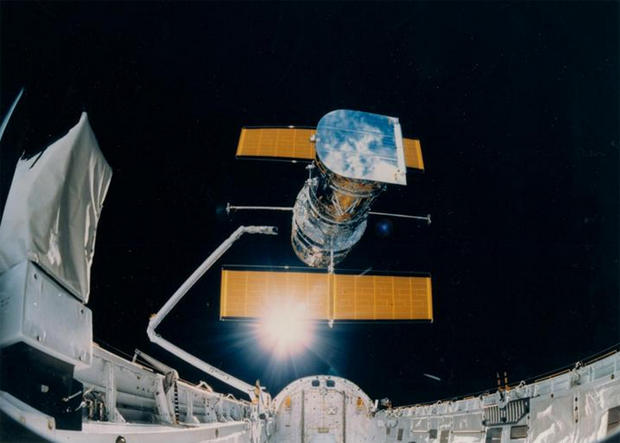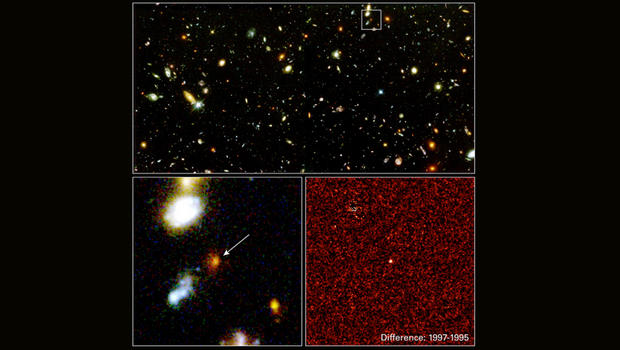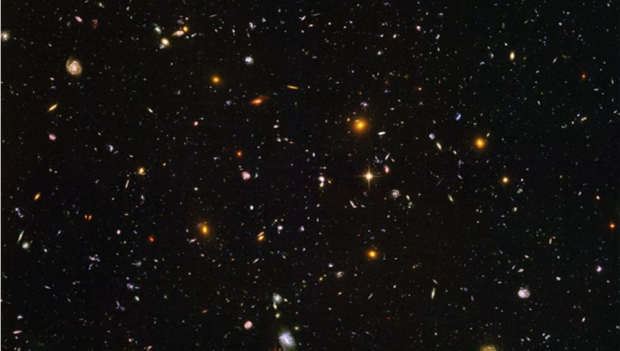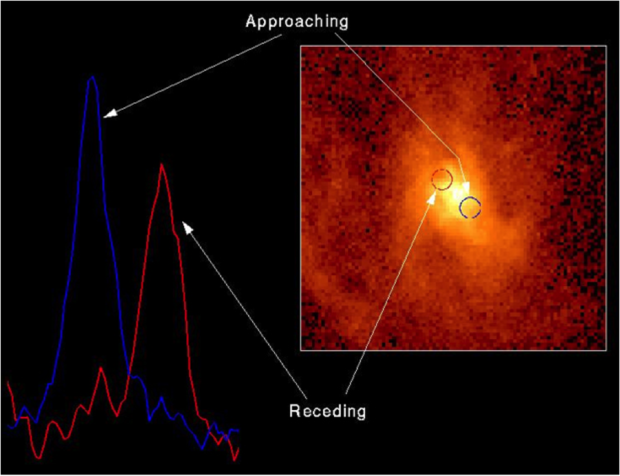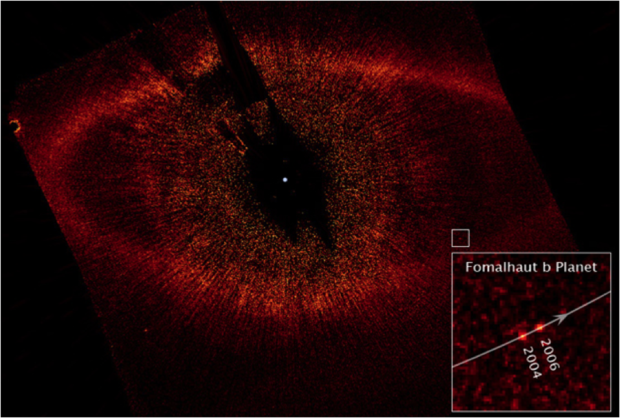Top 5 discoveries from the Hubble Space Telescope
Twenty five years ago, astronomers debated whether supermassive black holes actually existed, understood the age of the universe with an uncertainty of about a factor of two and could only detect fully formed galaxies within about 7 billion light years of Earth.
When the first stars formed and how they assembled into the vast structures that would ultimately become galaxies were unknowns, the answers hidden in the depths of cosmic space and time. No one knew for sure whether planets orbited other suns and if so, whether it would be possible to actually get an image of one.
And from the public's perspective at the dawn of the Internet age, astronomy beyond the edges of our solar system was a mostly black-and-white-film affair.
Enter the Hubble Space Telescope, with its digital cameras and spectrometers, multi-wavelength filters and rock-solid stability, high above Earth's obscuring atmosphere.
Click through to learn about Hubble's astonishing discoveries and how they changed everything.
Big Science rock star
Launched aboard the shuttle Discovery 25 years ago this April 24, the space telescope has revolutionized optical astronomy and in the process entered the public consciousness as a Big Science rock star, its spectacular pictures gracing everything from grammar school textbooks to album covers, book jackets, calendars and postage stamps.
While other, much larger current and planned ground-based telescopes are pushing the frontiers of astronomy ever deeper, the space telescope's perch above the atmosphere still gives it an unparalleled advantage.
And while Hubble shares credit with ground-based observatories for some of its major achievements, it is, and remains, at the forefront of modern astronomy a quarter of a century after launch.
"It's just made these huge contributions. ... It's re-written a lot of what we know," said Hubble astronomer Adam Riess, who shared the 2011 Nobel Prize in physics for his work verifying the existence of dark energy.
Mario Livio, an astrophysicist who works with Riess at the Space Telescope Science Institute on the campus of Johns Hopkins University in Baltimore, said, "there is essentially no area of astronomy and astrophysics where Hubble didn't contribute something quite significant."
Here are five of the Hubble Space Telescope's top discoveries.
How old is the universe?
One of the key questions Hubble was built to answer was simple to state: How old is the universe? In the 1920s, Edwin Hubble, using the 100-inch telescope at Mount Wilson, California, proved that galaxies exist beyond our Milky Way and showed the universe was expanding, with more distant galaxies flying away at higher and higher velocities.
But to determine the age of the universe, astronomers needed a precise understanding of the distances to remote galaxies and their velocities. Then, by "running the film backwards," they could figure out how long the universe had been expanding and, therefore, how old it must be.
One way to figure out how far away a remote galaxy might be is to look for individual Cepheid variable stars in the target galaxy -- suns that pulsate with a frequency directly related to their intrinsic brightness. By comparing the brightness of the distant Cepheids to nearby relatives, astronomers could compute the distance to the remote galaxy. That's hard to do from Earth, but astronomer Wendy Freedman and a team of researchers used Hubble's extraordinary resolution to spot Cepheids in more than two dozen galaxies.
Those data, combined with observations by other ground- and space-based instruments, allowed astronomers to eventually pin down the age of the universe at 13.8 billion, plus or minus 3 percent.
Next...
The rate of a universe expanding
In the late 1990s, two teams of researchers led by Saul Perlmutter and Brian Schmidt engaged in a friendly-but-intense competition to measure how the cosmic expansion might have changed since the big bang by using another type of standard candle -- Type 1a supernovas -- to determine the distances to extremely remote galaxies.
If the expansion of the universe was slowing down, as seems intuitively obvious, one would expect the light from remote Type 1a supernovas to be brighter, and thus closer, than they would be in a universe expanding at a constant rate.
But as the competing teams discovered, using ground-based telescopes, Type 1a supernovas in distant galaxies were much fainter than expected, implying they were farther away than they would be in a decelerating universe. The unavoidable conclusion was that the expansion of the universe was speeding up, not slowing down, due to some sort of repulsive "dark energy" pervading the cosmos.
Riess, a member of Schmidt's team, used the space telescope to find some of the most distant Type 1a supernovas ever discovered. The data indicated the universe did, in fact, decelerate over the first eight billion years or so of its life. And then, as it thinned out, dark energy became dominant and the expansion began speeding up. Perlmutter, Schmidt and Riess shared the 2011 Nobel Prize in physics for their discovery of dark energy.
Next...
Stars and galaxies like grains of sand
In late 1995, Robert Williams, then director of the Space Telescope Science Institute, used his discretionary observing time to aim Hubble at an apparently empty region of deep space. The resulting 342 images were combined into a single jaw-dropping picture amounting to a cosmic bore hole into the depths of space and time.
Stunned astronomers counted more than 1,500 galaxies in an area of the sky about the size of a grain of rice held at arm's length, the most distant of which were shining less than a billion years after the big bang. The original Hubble Deep Field was followed by other, even deeper views, revealing galaxies in the process of forming less than 500 million years after the big bang.
The latest efforts, known as Frontier Fields, are taking Hubble to the limit, using the gravity of entire clusters of galaxies to magnify the light emitted by more distant, much more remote star swarms in the distant background in a bid to fill in at least some of the blanks in the story of galactic evolution.
Along with proving galaxies evolved much more rapidly than previously suspected, the deep field projects also provide a richly detailed history of star formation, "the rate at which the universe as a whole, not individual galaxies, forms new stars," said Livio.
The Hubble deep fields show that by the time the universe was about 500 million years old, "we already had a very high star formation rate, and then that star formation rate reached a peak at about nine, 10 billion years ago," Livio sad. "It's actually been declining ever since."
Next...
Outing supermassive black holes
When the Hubble Space Telescope was launched, black holes with masses of a few suns were believed to exist, the end result of supernova explosions in massive suns that produced compact, collapsed cores with gravity so intense not even light could escape. But data confirming the existence of supermassive black holes was sparse and subject to debate. And it wasn't because astronomers did not know how to look.
While back holes are, by definition, not directly observable, astronomers knew that any in-falling gas would be accelerated to extreme velocities, releasing high-energy X-rays and gamma rays that could, in theory, be seen. But doing so with instruments forced to peer through Earth's atmosphere was a difficult challenge and clear proof remained elusive.
Six months after the first shuttle-servicing mission restored Hubble's vision in December 1993, Hubble astronomers unveiled a pioneering observation of the core of an active galaxy -- M87 -- some 50 million light years from Earth. Hubble's Faint Object Spectrograph captured light from five positions around a rapidly spinning disk of gas at the core, allowing astronomers to measure its velocity.
According to Newton's law of gravity, the velocity of material in the disk depends directly on the mass concentrated in the core. When Hubble astronomers crunched the numbers, they determined a black hole with a mass of more than 3 billion suns was the only possible explanation for the velocity of the material in the disk.
The observation was hailed as a "textbook" proof that supermassive black holes existed. Subsequent observations would show such black holes are common features of large galaxies. They may, in fact, be essential to their formation.
Next...
Planets, planets everywhere
In July 1994, just seven months after the first shuttle servicing mission, fragments of a comet torn apart by Jupiter's gravity slammed into the giant planet's atmosphere, blasting world-size blemishes in the cloud tops that were easily visible to amateur and professional astronomers alike.
But the clearest, most spectacular views came from the Hubble Space Telescope, a powerful demonstration of the observatory's ability to provide flyby-class views of other planets in Earth's solar system.
Hubble has been used to track Venusian clouds and dust storms on Mars, to study the churning atmospheres of Jupiter and Saturn, to monitor Saturn's rings and auroral displays on both planets and to keep tabs on Uranus and Neptune and their many moons. More recently, Hubble has been extensively used to map the moons of Pluto and help find post-flyby targets in the remote Kuiper Belt for NASA's Pluto-bound New Horizons spacecraft.
Getting spectacular images of Earth's neighbors was not a surprise. But actually imaging a planet orbiting another star -- a feat Hubble achieved in November 2008 -- and spectroscopically examining the atmospheres of several other extra-solar planets, are considered major achievements.
"When Hubble was launched, we didn't even have evidence there were planets around other stars," Riess said. "Not only have those been found, Hubble has helped characterize those. It's truly remarkable."
